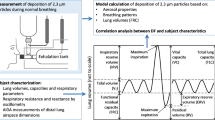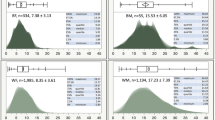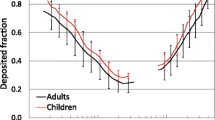Abstract
Purpose. To develop a rapid and reliable method for predicting the pattern of aerosol particle deposition within the human lungs, using artificial neural networks (ANNs).
Methods. Experimental data from the literature were used to train multi-layer perceptron (MLP) networks to allow for prediction of regional and total aerosol particle deposition patterns in human lungs. These data covered particle sizes in the range 0.05-15 μm and three different breathing patterns (ranging from “quiet” breathing to breathing “under physical work conditions”). Three different MLPs were trained, to provide separate predictions of aerosol particle deposition in the laryngeal, bronchial, and alveolar regions. The total deposition fraction for a given set of breathing conditions was computed simply as the sum of the outputs produced from the corresponding regional deposition MLPs.
Results. The ANNs developed are shown to give highly accurate predictions for both regional and total aerosol deposition patterns for all particle sizes and breathing conditions (with errors typically less than 0.04%).
Conclusions. We conclude that the current set of ANNs can be used to give good predictions of particle deposition from polydisperse pharmaceutical aerosols generated from breath-actuated dry powder inhalers, nebulizers, and metered dose inhalers with spacers.
Similar content being viewed by others
REFERENCES
J. S. Patton. Mechanisms of macromolecule absorption by the lung. Adv. Drug Deliv. Rev. 19:3–36 (1996).
I. Ashurst, A. Malton, D. Prime, and B. Sumby. Latest advances in the development of dry powder inhalers. Pharm. Sci. Technol. To. 3:246–256 (2000).
K. J. McDonald and G. P. Martin. Transitions to cfc-free metered dose inhalers-into the millennium. Int. J. Pharm. 201:89–107 (2000).
R. N. Lawrence. Intelligent inhalers for systemic administration? Drug Discov. Today 6:445–446 (2001).
M. L. Everard. Aerosol therapy past, present, and future: a clinician's perspective. Respiratory Care 45:769–776 (2000).
W. Stahlhofen, G. Rudolf, and A. C. James. Intercomparison of experimental regional aerosol deposition data.J. Aerosol Med. 2:285–308 (1989).
J. Heyder, J. Gebhart, G. Rudolf, C. F. Schiller, and W. Stahlhofen. Deposition of particles in the human respiratory tract in the size range 0.005-15μm, J. Aerosol Sci. 17:811–825 (1986).
W. Hofmann and L. Koblinger. Monte carlo modeling of aerosol deposition in human lungs. Part III: Comparison with experimental data. J. Aerosol Sci. 23:51–63 (1992).
T. B. Martonen, C. J. Musante, R. A. Segal, J. D. Schroeter, D. Hwang, M. A. Dolovich, R. Burton, R. M. Spencer, and J. S. Fleming. Lung models: Strengths and limitations. Respiratory Care 45:712–736 (2000).
E. Weibel. Morphometry of the human lung. Springer-Verlag, Berlin, 1963.
C. J. Richardson and D. J. Barlow. Neural network computer simulation of medical aerosols. J. Pharm. Pharmacol. 48:581–591 (1996).
G. Spellman. An application of artificial neural networks to the prediction of surface ozone concentrations in the United Kingdom. Appl. Geogr. 19:123–136 (1999).
G. Tkacz. Neural network forecasting of Canadian GDP growth. Int. J. Forecasting 17:57–69 (2001).
J. Ellenius and T. Groth. Transferability of neural network-based decision support algorithms for early assessment of chest-pain patients.Int. J. Med. Inform. 60:1–20 (2000).
J. Gasteiger, X. Li, and A. Uschold. The beauty of molecular surfaces as revealed by self-organizing neural networks. J. Mol. Graphics 12:90–97 (1994).
J. Devillers. Neural networks in QSAR and drug design. Academic Press, London, 1996.
K. Takayama, A. Morva, M. Fujikawa, Y. Hattori, Y. Obata, and T. Nagai. Formula optimization of theophylline controlledrelease tablet based on artificial neural networks. J. Control Rel. 68:175–186 (2000).
K. M. Tolle, H. Chen, and H. Chow. Estimating drug/plasma concentration levels by applying neural networks to pharmacokinetic data sets. Decis. Support Syst. 30:139–151 (2000).
K. K. Peh, C. P. Lim, S. S. Quek, and K. H. Khoh. Use of artificial neural networks to predict drug dissolution profiles and evaluation of network performance using similarity factor. Pharm. Res. 17:1384–1388 (2000).
D. E. Rumelhart, G. E. Hinton, and R. J. Williams. Learning internal representations by error propagation. In D. E. Rumelhart and J. L. McClelland (eds.), Parallel Distributed Processing: Explorations in the Microstructures of Cognition, MIT Press, Cambridge, pp. 318–362.
R. M. Burton and G. J. Mpitsos. Event-dependent control of noise enhances learning in neural networks. Neural Networks 5: 627–637 (1992).
C. P. Yu. C. K. Diu, and T. T. Soong. Statistical analysis of aerosol deposition in nose and mouth. Am. Ind. Hyg. Assoc. J. 42: 726–733 (1981).
T. B. Martonen, I. Katz, K. Fults, and A. J. Hickey. Use of aerosol respirable fraction to predict lung deposition. Pharm. Res. 9: 1634–1639 (1992).
C. F. Schiller, J. Gebhart, J. Heyder, G. Rudolf, and W. Stahlhofen. Deposition of monodisperse insoluble aerosol particles in the 0.005 to 0.2 μm size range within the human respiratory tract. Proceedings of the 6th symposium on inhaled particles. Ann. Occup. Hyg. 32:41–49 (1989).
C. S. Kim. Methods of calculating lung delivery and deposition of aerosol particles. Respiratory Care 45:695–711 (2000).
Rights and permissions
About this article
Cite this article
Nazir, J., Barlow, D.J., Lawrence, M.J. et al. Artificial Neural Network Prediction of Aerosol Deposition in Human Lungs. Pharm Res 19, 1130–1136 (2002). https://doi.org/10.1023/A:1019889907976
Issue Date:
DOI: https://doi.org/10.1023/A:1019889907976




